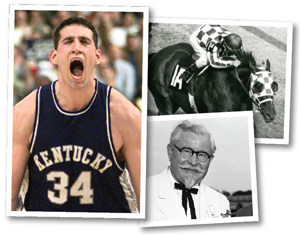September 14, 2025
Getting ready for boat show, 1995

Sam Sherrow with Flerlage Marine in Richmond polished a Sea Ray 250 Sundancer February 8, 1995 at Lexington Center where the Sport, Boat and Recreation Show was to open the next day. This year’s Kentucky Sport, Boat and Recreation Show opened yesterday at Lexington Center and runs through Sunday. Photo by Ron Garrison | Staff
February snowstorm, 1985
Gov. John Y. Brown Jr.’s budget address, 1982

Kentucky Gov. John Y. Brown Jr. delivered his budget address to a joint session of the Legislature on Jan. 7, 1982. Brown’s $9.97 billion budget proposed no new taxes and was to provide money for mandatory statewide kindergartens and salary raises for teachers, firefighters, police officers and state employees. Gov. Matt Bevin is scheduled to issue his second State of the Commonwealth address to the Kentucky General Assembly at 7 p.m. Wednesday. Photo by David Perry | Staff
LSU coach Dale Brown tosses sportcoat onto UK floor, 1976

A frustrated LSU coach Dale Brown tossed his plaid sportcoat onto the Kentucky emblem at midcourt, Feb. 2, 1976, at Memorial Coliseum. The game was marred by four technical fouls, 53 fouls, 63 free-throw attempts, a six-minute stoppage in play that resulted in a five-point play, and Brown being escorted from the game officials’ locker room by a university police officer. The Tigers started the game hot and had a 34-21 lead after Kenny Higgs’ five-point play. Kentucky’s Larry Johnson fouled Higgs hard on a made basket and was assessed a technical. UK coach Joe B. Hall was given a technical after saying the call was “horse manure,” or words to that effect. “They (the officials) don’t realize that’s not a dirty word in the Bluegrass,” Hall joked after the game. After the delay, UK started a comeback, one that Brown thought was helped by the officials, culminating with his double technicals in the second half. “Joe Hall won the game and he should be complimented,” Brown later said. “He intimidated the officials.” Immediately after the game, Brown followed the officials to their small dressing room under the Coliseum. The coach didn’t bother to close the door as he said, “Reggie (Copeland), you let them call you an S.O.B. (an epithet emphatically denied by Hall) and you didn’t have the guts to throw him out! You let an assistant coach bat the ball halfway across the floor!” A campus police officer then entered the room to escort Brown out. “Get your arm off me, fella,” Brown said. “These guys (the campus police) are as bush league as they are (the officials)!” Brown later went to the UK locker room to shake Hall’s hand. “I could match every complaint he had,” Hall said. “After the game he was complaining generally about the officials, and I was generally agreeing with him.” Click on the image for a closer look. And click here to read the stories on the game form the Lexington Leader and the Lexington Herald. Photo by E. Martin Jessee | Staff
Fence separating races removed, 1974
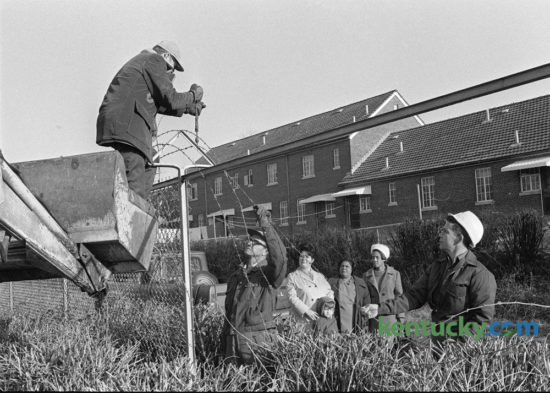
An eight-foot fence that had separated black and white residents of the Blue Grass-Aspendale Housing Project came down Jan. 30, 1974. Taking down the fence, which was topped with barbed wire, were, from left, Jay Martin, Warren Gerton and supervisor Earl Osten. Looking on, from left, were residents Ruby Anderson and her son Steve; Edith Hines, president of the residents council; and Lola Jones, also a council member. A story accompanying the photo referred to the fence as Lexington’s own “Berlin Wall.” The story quoted Leonard Hunt, the city’s housing director at the time, as saying the fence was a symbol of segregation, “and we are seeking integration.” Hunt said the mayor at the time, Foster Pettit, was surprised to learn about the fence and its original intent. Photo by John C. Wyatt | Staff
since 1939
Castlewood doll show winners, 1947
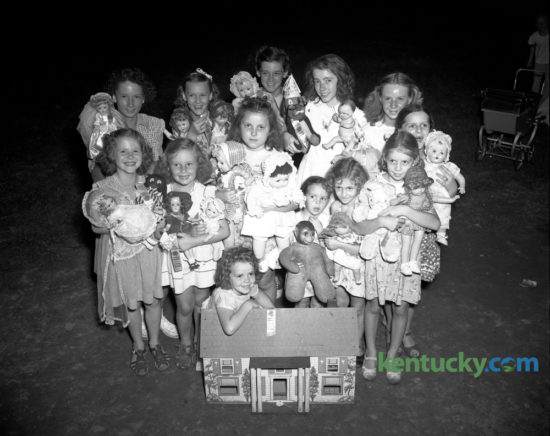
The first-place winners in the Castlewood section of the citywide doll show on Aug. 8, 1947, were shown with their dolls, which won in categories including prettiest, ugliest, biggest and smallest. Shown with her dollhouse is Mary Ann Hubbuch. First row from left: Margaret Marie Sweeney, Elizabeth Gayle Mount, Phyllis Jean Pridemore, Patsy Jo Garrison, Jo Ann Cox and Juanita Garrison. Second row from left: Sally Ann Carlin, Mary Anne Davidson, Eudean Bowling, Mary Ann Graves, Pauline Garrison and Glenna Davidson. Published in the Lexington Herald-Leader on Aug. 10, 1947. Herald-Leader Archive Photo
Arkansas Gov. Bill Clinton campaigns in Frankfort, 1992
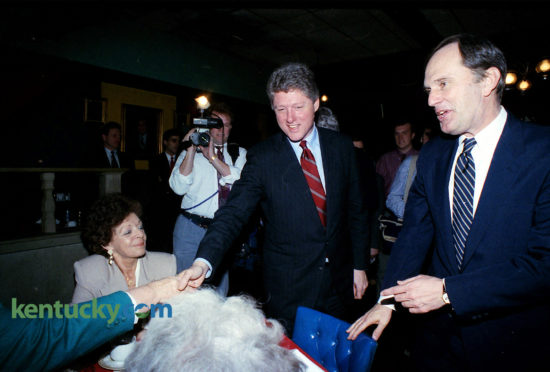
Arkansas Gov. Bill Clinton and Kentucky Gov. Brereton Jones greeted diners at Flynn’s Restaurant and Statesman Lounge in Frankfort on Feb. 4, 1992. Clinton took time out from campaigning in New Hampshire to gather the endorsements of Jones and a host of other top Kentucky Democratic officials. In an impassioned speech to about 300 people crammed into the Capitol Rotunda, Clinton acted as if he already was running against Bush rather than his opponents in the Democratic primary. He never mentioned any of his Democratic opponents by name; U.S. Sens. Tom Harkin of Iowa and Bob Kerrey of Nebraska, former U.S. Sen. Paul Tsongas of Massachusetts, and former California Gov. Jerry Brown. Clinton said Bush and the Republicans have been sending the wrong message to the nation: “Turn a quick buck, get it while you can and walk away with the money.” This attitude has helped produce severe economic problems that Bush does not understand, Clinton said. Later, at a news conference outside Flynn’s restaurant, reporters didn’t ask Clinton the kinds of questions about marital fidelity that made national news the week before. Instead, most of the questions dealt mainly with details of his economic and educational proposals. Jones’ endorsement was important because it could influence the state’s 61 delegates to the Democratic presidential nominating convention. Clinton returned that night to New Hampshire, which held the first Democratic primary two weeks later. He won that primary, kicking off his successful run to the White House that November. Jennifer Podis | staff
UK basketball’s Bill Spivey and Bobby Watson, 1950
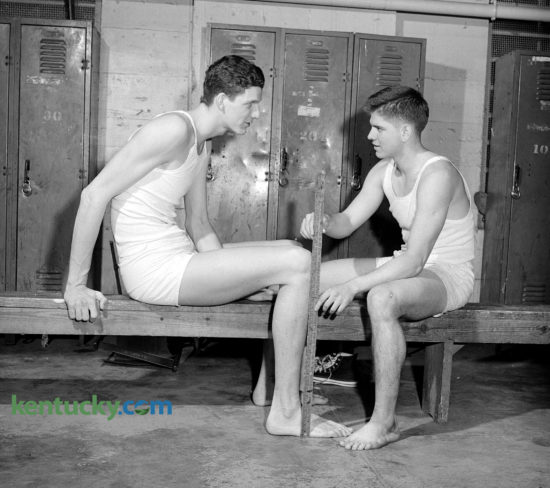
University of Kentucky basketball sophomores Bill Spivey, left, and Bobby Watson compared the lengths of their lower legs in the Alumni Gym locker room in March 1950. The 1949-50 seasson was the Wildcats’ final season at Alumni; they moved to Memorial Coliseum the next fall. Watson was the team’s shortest player, measuring 5 foot 10, while Spivey was the tallest at 7 feet. The top of Spivey’s knee to floor was 26.5 inches, while Watson’s was 21.5. Spivey, UK’s first 7-foot player, had dreams of playing in the NBA, but those dreams were dashed after he was implicated in a point-shaving scandal in the early 1950s. Click here to see more images from our archives of Spivey. Watson, the fifth 1,000-point career scorer in UK basketball history, died Tuesday. He was 86. Click on the image for a closer look. Published on March 2, 1950, in the Lexington Leader. Herald-Leader Archive Photo
Funeral for fallen Powell County officers, 1992
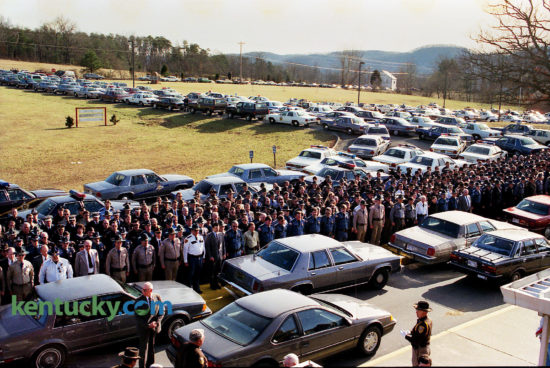
About 700 law officers from Kentucky, Ohio and Indiana attended the funerals for Powell County Sheriff Steve Bennett and Arthur Briscoe, his deputy and brother-in-law, on Feb. 2, 1992, in Stanton. The two were shot and killed three days earlier after Briscoe tried to serve a warrant on Ralph Baze Jr. for officials in Toledo, Ohio. Baze opened fire on them with an SKS assault rifle, then took their guns and fled into the hills. “The sheriff’s car is riddled with bullets,” said Ed Robinson, a spokesman for the Richmond state police post. Baze gave himself up eight hours later by calling a 911 emergency number from near Ravenna, about 10 miles away in Estill County. He said he had been shot and asked police to come get him. The shootings left the county with one full-time deputy, Judge-Executive Forest Meadows said. Three days later, mourners filled the Powell County High School gymnasium for the afternoon service. Almost 700 officers in brown, blue, gray and green uniforms filed in, filling the home-side bleachers. The procession to the cemetery stretched more than a mile. Photo by Frank Anderson | Staff
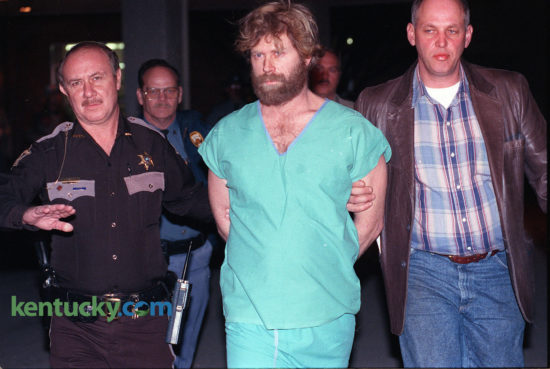
Ralph Baze, center, was taken to the Montgomery County Regional Jail on Jan. 30, 1992. Baze was arrested at Mary Chiles Hospital in Mount Sterling after being treated for a gunshot wound. Baze was convicted and sentenced to die. He was scheduled for execution in 2007 but a stay was issued after he sued on the grounds that execution by lethal injection using the “cocktail” prescribed by Kentucky law constitutes cruel and unusual punishment. The United States Supreme Court rejected that claim in 2008. He later challenged Kentucky’s clemency system but lost his appeal in 2015. He is on Death Row at the Kentucky State Penitentiary in Eddyville. Photo by Ron Garrison | Staff
Tim Couch picks Kentucky, 1995
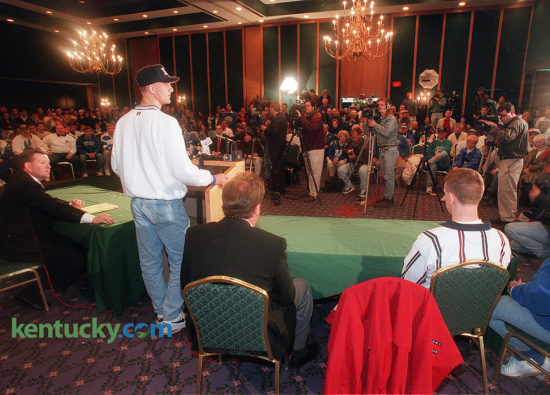
High school football standout Tim Couch announced his intention to sign a letter-of-intent to play football at the University of Kentucky, Dec. 24, 1995. About 200 fans attended the news conference in a ballroom at the downtown Lexington Radisson Hotel, 90 minutes before the tip-off the annual Kentucky-Louisville basketball game across the street at Rupp Arena. “I came up to watch the basketball game, but I would have come up just to see this,” said fan Eddie Evans, 49, of Corbin. After considering Auburn, Florida, Florida State, Notre Dame, Penn State and Ohio State, among others, Couch narrowed his list to UK and Tennessee. The Tennessee spin was that Couch could play behind star Vols quarterback Peyton Manning for a year, then step in as a starter in 1997, when Manning turned pro. “I didn’t want to just be another name in a great line of quarterbacks at a school. I wanted to start my own name here at Kentucky and hopefully get a big tradition started here,” Couch said. Rated the nation’s best quarterback prospect by most recruiting services, and possibly the best Kentucky football prospect since Paul Hornung left Louisville Flaget for Notre Dame in the 1950s, Couch threw for a national record 12,104 yards and 133 touchdowns over his four years. During his senior year, the 6-foot-5, 215-pounder threw for 3,916 yards and 42 touchdowns, leading Leslie County to a 12-2 record. He was named Gatorade’s national high school player of the year. “This is the best day of my life,” said Tim’s father, Elbert. “This is where we wanted him to go all along.” Couch signed with UK the following February. This year’s national signing day is Feb. 1 and UK expects to have one of the programs best recruiting classes. Click here to see other images of Couch from our archives. Photo by Mark Cornelison | Staff


